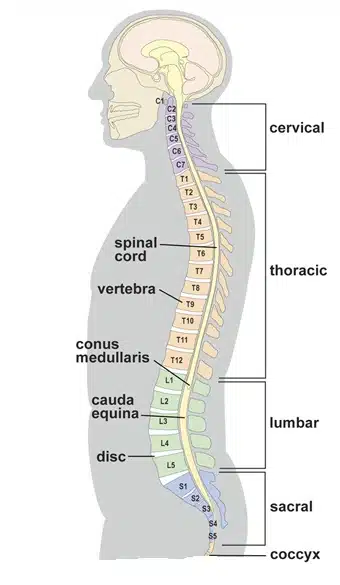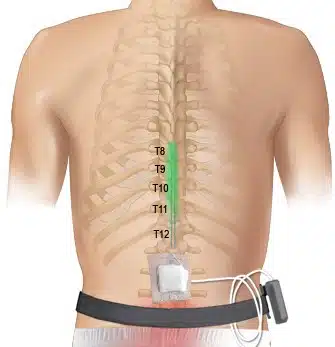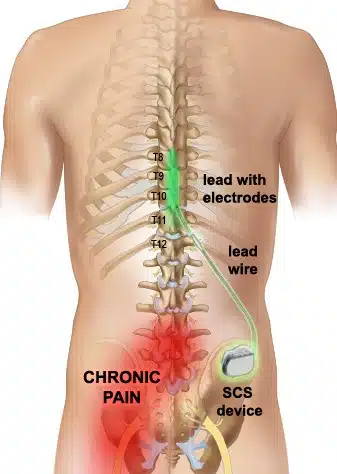Pain Procedure | Interventional Pain Management Treatment
Surgically implanted electrotherapy devices
If an individual is not experiencing sufficient control of pain and other symptoms, electrotherapy a treatment that directs mild electrical pulses to the problem area—may be an option.

Surgically implanted electrotherapy devices
These are implantable spinal cord stimulators (SCS) and implantable peripheral nerve stimulators. Clinical data offers inconclusive findings on the effectiveness of SCS, but in general they are more effective for arm and leg pain than they are for localized spine pain. Spinal cord stimulators are expensive.
Since the approval of spinal cord stimulation by the U.S. Food and Drug Administration in 1989, manufacturers have continued to develop features designed to make the devices used in spinal cord therapy smaller, more effective, and more comfortable.
- Spinal cord stimulation was first used to treat pain in 1967. Spinal cord stimulation was approved by the Food and Drug Administration (FDA) in 1989 to relieve pain from nerve damage in the trunk, arms, or legs, and now accounts for about 90 percent of all neuromodulation treatments. That number is expected to grow to manage chronic disease states as the population ages and as spinal cord stimulation is expanded to treat other diseases.
- Around the world, some 14,000 patients undergo spinal cord stimulator implants each year. Spinal cord stimulation (SCS) delivers mild electrical stimulation to nerves along the spinal column, modifying or blocking nerve activity in a non-medicinal way to minimize the sensation of pain reaching the brain.
Growing Interest in Spinal Cord Stimulation
Spinal cord stimulation has been used for decades, and is being recommended for an increasing number of conditions. Failed back surgery syndrome, cervical and lumbar radiculitis, neuropathy, and complex regional pain syndrome are some conditions that may be helped by the therapy.
 High Frequency Spinal Cord Stimulation
High Frequency Spinal Cord Stimulation
One of the changes in spinal cord stimulation is the introduction of systems using high frequency pulses, rather than the low frequencies traditionally used. High-frequency therapy was approved by the U.S. Food and Drug Administration in 2015, and the medical literature has shown some advantages to high-frequency therapy.
- One research study showed that with high-frequency therapy, pain was reduced by more than half in 85% of study participants with back pain and 83% of those with leg pain when high-frequency therapy was used.
- In the same study, when low-frequency therapy was used, pain was reduced by more than half in 44% of participants with back pain and 56% of those with leg pain.
The effectiveness of spinal cord stimulation in treating back pain is notable. While both high- and low-frequency systems effectively relieve radicular pain in the legs and feet, low-frequency therapy has generally not worked as well for back pain.
The study also found significantly more people improved their functioning and were able to reduce or eliminate opioid use when using high-frequency therapy rather than low-frequency therapy. This reduction in opioid use by study participants may be encouraging for individuals wanting to reduce their own reliance on opioid medication. More than three-fourths of the study participants used opioid medications.

Additional Forms of Spinal Cord Stimulation
Two other forms of spinal cord stimulation have further expanded the therapy’s potential usefulness in recent years.
Dorsal Root Ganglion Therapy
Dorsal root ganglion therapy is a targeted approach that has been especially effective in treating groin and foot pain. Rather than working through the spinal cord, the therapy is applied to the dorsal root ganglion, a grouping of specialized nerves near the spinal cord at the base of each branching spinal nerve. These areas have often been challenging to treat with other forms of spinal cord stimulation. The U.S. Food and Drug Administration has approved dorsal root ganglion stimulation for complex regional pain syndrome.
Burst Spinal Cord Stimulation
Burst spinal cord stimulation, which delivers closely spaced, high-frequency current, has been effective in relieving pain without the associated tingling sensation called paresthesia. It appears to be helpful for people who have built up a tolerance for the pain-relieving effects of traditional spinal cord therapy.
MRI-Safe Devices Offered
In the past, people who needed to have magnetic resonance imaging (MRI) scans were not able to benefit from spinal cord stimulation. Energy from an MRI was considered hazardous to the implanted devices.
New MRI-safe spinal cord stimulation devices are now available. In some cases, the device allows whole-body MRI scans, while others are designed to accommodate only certain types of MRIs.
This is a major advantage, since many people who are candidates for spinal cord stimulation have coexisting conditions that must be monitored with MRIs.
Wireless System, Miniaturization Make Process Less Invasive
Spinal cord stimulation is becoming less invasive due to miniaturization of generators and other devices. With smaller generators, the incision needed to insert them has also gotten smaller. For example, one new device offers a generator the size of a matchstick.
A new wireless system takes miniaturization a step further. The leads, electrodes, and a micro-transmitter are all implanted in the spinal space with a hollow needle. A small wearable antenna sends signals wirelessly to the electrical contacts in the spinal cavity. This eliminates the need for more extensive surgery to insert the generator as well as the need to eventually replace it. It also avoids potential irritation or infection in the area where the generator is implanted.
Rechargeable vs. Non-rechargeable: The Pros and Cons
Rechargeable spinal cord stimulators can last several years longer than a traditional SCS before needing replacement.
Rechargeable generators are often smaller and last longer before they need to be replaced. A potential drawback is that they need to be charged regularly, and the use of high-frequency spinal cord stimulation may require even more frequent charging.
Non-rechargeable generators are simpler in terms of day-to-day maintenance, but require a surgical revision to change the battery. This type of generator may be easier for patients who have difficulty with technology.
Therapy Becoming Easier to Use
Other innovations making daily life easier for people using spinal cord stimulation include:
- Automatic adjustments. Controllers with sensors that automatically adapt stimulation levels to people’s movements are available. Other models offer multiple programs of stimulation based on factors including pain and body movements.
- Long-lasting generators. As generators have gotten smaller, their batteries have also improved. Some rechargeable implantable pulse generators are now expected to last 10 to 25 years before needing to be surgically removed.
Innovations in the devices used for spinal cord stimulation may offer improved pain relief, comfort, and convenience over earlier models. In the future, there may be advancements that track movement and adapt the stimulation accordingly, or even use radiofrequency wireless technology that could avoid the need for an implanted generator.

Who May Benefit from Spinal Cord Stimulation
A two-step screening process is typically used to determine whether a person is a good candidate for spinal cord stimulation. The first step is based on the person’s medical condition and begins with a thorough assessment by the doctor.
Chronic Pain Conditions Treated with Spinal Cord Stimulation
A general condition known as failed back surgery syndrome is one of the most common reasons spinal cord stimulation is used. The term describes chronic pain after one or more back or neck surgeries fails to alleviate persistent low back pain, leg pain (sciatica or lumbar radiculopathy) or arm pain (cervical radiculopathy).
The therapy also has the potential to alleviate pain related to the following conditions:
- Arachnoiditis, painful inflammation and scarring of the meninges (protective layers) of the spinal nerves
- Chronic back pain with or without leg pain
- Chronic neck pain with or without arm pain
- Complex regional pain syndrome, a chronic progressive disease characterized by severe pain and swelling
- Peripheral neuropathy, a constant burning pain of the legs caused by the most distant nerves dying off
- Complex regional pain syndrome (reflex sympathetic dystrophy), a progressive disease of the nervous system in which patients feel constant burning pain
- Refractory angina, which causes chest pain, shortness of breath, and fatigue
Spinal cord stimulation is recommended for an increasing number of painful health problems, and this is not a comprehensive list of conditions the therapy may help.
If the person fits the criteria for spinal cord stimulation, the doctor will arrange a trial period—the second step in the screening process—to see how well the temporary therapy eases the individual’s pain.
When Spinal Cord Stimulation Is Not Advised
Spinal cord stimulation and peripheral nerve field stimulation therapy are not for everyone. These therapies are usually not recommended for individuals who:
- Have a systemic infection or infection at the site where the device would be implanted
- Use a demand-type cardiac pacemaker
- Have severe depression or another psychiatric condition that could be contributing to the pain
- Have untreated bleeding disorders
- Have untreated drug addiction issues
Medical research indicates that tobacco use is linked to worse outcomes with spinal cord stimulation. Smokers may be advised by the doctor to quit before beginning the therapy. Recreational drug use is also thought to reduce the chance of successful therapy, and should be discussed with the doctor.

Advantages of Spinal Cord Stimulation
The medical literature has shown that spinal cord stimulation is potentially effective for a number of chronic pain conditions, such as back pain, neck pain, and complex regional pain syndrome, that have not been helped by other treatments.
Spinal Cord Stimulation Therapy Is Reversible
Unlike most surgical procedures, spinal cord stimulation therapy is reversible. If a person decides at any time to discontinue the therapy, the electrical contacts, wires, and generator can all be removed and there are no permanent changes to the spine.
Other potential advantages of SCS include:
- Adjustable pain relief. Pain varies widely from person to person, and even within a single individual at different times. The number of pain adjustment options on the hand-held controller continues to grow as new models are introduced. In addition, some models adjust automatically to the person’s movements. Having control over pain can be a welcome change for those dealing with a chronic condition.
- Minimally invasive procedures. There is typically just one incision needed—to implant the generator—and ever-smaller generators do not require long incisions. The placement of the leads with electrodes is typically done with a hollow needle, rather than through an incision. It has few side effects and is easily reversible; if it doesn’t work or is no longer needed it can be removed.
- Reduced opioid use. The pain relief experienced with spinal cord stimulation and peripheral nerve stimulation may allow people to take fewer pain medications. Results in the medical literature show that more than a third of one study’s participants having high-frequency therapy reduced or stopped taking opioid medications. The study’s participants had been in chronic pain for an average of 13 years.
- Targeted pain relief. Instead of taking a medication that affects the whole body and causes sleepiness, constipation, or other problems unrelated to the pain, spinal cord stimulation delivers pain relief only where it is needed.
- Limited or no side effects. The therapy does not have the type of side effects associated with many medications.
- Cost-effective pain relief. Researchers have found that the costs associated with spinal cord stimulation compare favorably with alternatives, including non-surgical treatments.,
- Alternative to oral medication. The therapy offers another pain control option for those who have problems taking oral medication.
- No refills needed. The pain relief from spinal cord stimulation can continue for years, without a need for new pills or frequent office visits.
Spinal cord stimulation does not eliminate all pain, but has the potential to significantly reduce the pain. Achieving this level of pain control and cutting back on—or eliminating—reliance on prescription painkillers makes the therapy helpful in some situations.
Disadvantages and Risks of Spinal Cord Stimulation
Spinal cord stimulation is considered successful if pain is reduced pain by at least half, but not everyone reaches that goal. With traditional low-frequency therapy, about 50% to 60% of those using spinal cord stimulation reach that goal, but studies have shown more than 80% experience significant pain relief when using newer, high-frequency therapy.
Device-Related Complications Common
Spinal cord stimulation and peripheral nerve field stimulation are considered generally safe, with the potential risks mainly related to the surgical procedures required for a trial period or long-term therapy.
One extensive study in the medical literature found 38% of the research participants had device-related problems.3 The most common complications were unintended movement (also called migration) of the leads, failed connections in leads, and breakage of leads.
While complications related to the implanted devices are relatively common, they appear to be declining with advances in technology and surgeons’ skills.
Serious Injuries Are Rare
The same study that looked at device-related problems also found that 12% of participants experienced pain at the site of the implanted generator right after surgery and 4.5% developed infections.
Device-related issues are more common than physical problems. Serious adverse events, such as a hemorrhage in the epidural space or neurological damage caused by an injury to the nerve root or spinal cord—including paralysis—are not common.5
Surgery Is Required
Both the trial period and insertion of most permanent spinal cord stimulation devices involve an implant and surgery. As with any such procedure, there are certain risks and potential complications, such as an infection and bleeding.
The recovery period is generally six to eight weeks, with some people experiencing intense pain for several days or more following either the trial period or permanent implantation of the spinal cord stimulation devices. Medication may be needed to control the pain.
While many generators can be recharged and used for years, if a new generator is needed, another surgery will be needed to remove and replace it.
Additional Disadvantages
Less serious disadvantages of spinal cord stimulation devices include:
- Fluctuations in stimulation. Unwanted changes in stimulation may include a jolting or shocking feeling. The device should be turned off and the doctor contacted if this occurs.
- Pain is not resolved. Spinal cord stimulation interferes with pain signals sent to the brain, but does not treat the underlying condition. People using this therapy need to continue working with others on their health care team.
- Reaction to pressure. Those using spinal cord stimulation should not take part in activities that add pressure to the body. Scuba diving more than 10 meters below the surface should be avoided, and the doctor should be consulted before entering a hyperbaric chamber.
- Electromagnetic interference. Strong interference, such as from a defibrillator or MRI (if the spinal cord stimulation device is not MRI-safe), can damage the generator, leading to severe burns, other serious injury, or death. Skin irritation may develop near the generator related to charging.
- Discomfort around generator. Some people find the implanted generator irritating or uncomfortable.
Relieving pain with spinal cord stimulation has some drawbacks. It is a different experience compared with painkillers or other pain control techniques. Learning as much as possible about spinal cord therapy can help a person decide on the best option to ease chronic pain in the back, neck, or limbs.
 High Frequency Spinal Cord Stimulation
High Frequency Spinal Cord Stimulation